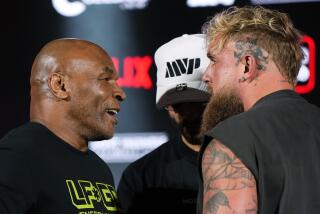In ‘Tyson,’ the boxer pulls no punches
- Share via
The head-shrink session is about to resume.
In a Beverly Hills hotel, at a table overlooking the garden, James Toback and Mike Tyson are energetically discussing the Oedipus complex, madness, women and, of course, boxing. It’s the latest installment of their ongoing quarter-century dialogue that now has become the centerpiece of Toback’s intriguing and unsettling “documentary portrait”: “Tyson.” The movie opens in theaters Friday.
In the ring, “Iron Mike” used to make his opponents kiss the canvas just minutes or even seconds after they came out of their corners. His demeanor and muscle-plated physique evoked an enraged rhino and the coiled savagery of his blows made observers wince. But as Toback’s movie depicts, the former world heavyweight champion’s most brutally relentless adversary always was himself.
The film, for which Tyson supplies the entire narration, follows its subject as he wanders the solitary labyrinths of his mind: from his violent and humiliating Brooklyn youth, when he was mocked as a fat kid who wanted to be a street hustler; through his rapid rise to his sport’s pinnacle when he was barely out of his teens; to his appalling public meltdown that resulted in a broken marriage, a rape conviction, prison time and the disgraceful episode of the Bitten Ear, followed by a half-hearted comeback and retirement.
Those scenes set the stage for the 91-minute pugilistic passion play that is “Tyson,” in which audiences will discover a man steeped in self-recriminations, desperately and apparently sincerely struggling, at 42, to figure out who he is and how he nearly allowed his demons (drugs, addictive sex, thuggish outbursts) to destroy him.
“Darkness is very alluring,” Tyson says in his soft, incongruously high-pitched voice. “I know it kind of sounds crazy, but the dark world is just fascinating. We call it, where I come from, we call it dancing with the devil.”
--
Digging deep
In venturing into the darkness, “Tyson” becomes a harrowing travelogue into one man’s inner Ninth Circle, with the unseen Toback asking questions and gently nudging his subject along like a combination of Dr. Phil and the Roman poet Virgil, Dante’s intrepid guide. The movie has one or two self-consciously arty flourishes, including a shot of Tyson gazing meditatively at crashing ocean waves while we hear his voice intoning Oscar Wilde’s famous lines from “The Ballad of Reading Gaol” (“each man kills the thing he loves”).
Yet the film convinces us that, in contrast to his coarse, almost cartoonish popular persona, Tyson can be a thoughtful, insightful and eloquent warrior. “He has a poetic sensibility,” says Toback, “and if you allow it to come out, it comes out.”
Toback and Tyson met on the set of the director’s “The Pick-up Artist” (1987), when Tyson was a little-known puncher trying to make a name for himself in boxing rings in places like Troy, N.Y. He’d been trained by the late, legendary Cus D’Amato, who appears in archival footage as a more troubling figure than the kindly, white-haired Obi-Wan Kenobi he portrayed publicly.
“I have such a different perspective of boxing, from Cus D’Amato,” Tyson says, “a real dark perspective.” Reflecting on his mentor, Tyson makes clear his present revulsion at the old man’s preparation methods in the arts of war, which were grounded in the belief that a boxer should intimidate and humiliate his foes, constantly dehumanizing them, so that he has no qualms about inflicting maximum destruction on their bodies. “It was this real sick [stuff], you know,” Tyson says.
Destructive, and self-destructive, activity is a particular obsession of Toback, 64, the director-writer of several edgy, well-regarded films about high-risk behavior and cross-cultural intrigue (“Love and Money,” “Black and White”), and an Oscar-nominated screenplay author for “Bugsy.” As a younger man, he waged his own epic battles with drug abuse and gambling, striking Faustian bargains with himself that as long as he maintained his outstanding school grades he could indulge his sybaritic appetites as much as he pleased.
“I was doing stuff that no one else would believe in high school,” says Toback. “And then I went to Harvard; I was doing the same thing. And my last drug trip of my life, I flipped out on LSD when I was 19, and that ended it to a degree because I thought, ‘All of this is headed towards the abyss.’ ”
When the men’s friendship began, Tyson had been hanging out at football great Jim Brown’s house a lot, immersing himself in L.A.’s heady celebrity party scene. Tyson was intrigued by Toback’s tales of his own wretched excesses and a bond was forged. Always intrigued by his prismatic friend, Toback (who had written a book about Brown in the early ‘70s) finally decided the time had come to make his docu-portrait of Tyson.
It was Toback’s idea for Tyson to narrate the movie in a stream-of-consciousness style. The filmmaker stayed off-camera and out of his subject’s sightline while asking him open-ended questions such as, “What are your feelings about sex?” and “What is your relationship to money?”
The resulting passionate monologue presents a sympathetically subjective view of Tyson, the man, while turning Tyson, the myth, sideways. Lisping, blurting out his deepest insecurities and occasionally wiping tears from his tattooed cheek, Tyson emerges in the film as a massively conflicted, emotionally outsized man-child in the pummeled land.
“It’s like a portrait of these great, tortured artists like Gaugin and Van Gogh,” Toback says. “You look at their self-portraits and they’re filled with turmoil and contradiction.”
A number of archetypal themes shadow Tyson’s on-screen ruminations: fathers and father surrogates (usually either absentee or manipulative and authoritarian in Tyson’s case); male-female relations (Tyson confesses he’s attracted to strong women “and then I want to dominate her sexually”).
Tyson also spends a fair amount of the film’s second half beating up on himself, frequently with the same vicious relish he displayed toward his opponents. Asked whether he isn’t being overly harsh on himself at times, he shakes his head.
“I have to beat up on myself,” he says, “because nobody else will.” He refuses to pardon his past boorishness or brutality, or take refuge in his athletic triumphs. “I’m an out-of-shape, washed-up boxer, you know I mean? And my life, everything that I knew, the life that I once knew is just dead. . . . I don’t think about that.”
--
On the up and up
At present, Tyson says, he’s concentrating on trying to be a good father and staying clean, sober and out of trouble. Those sound like narrow attainments for a man who once struck fear in some of the toughest guys in the world. But as Tyson sees it, there’s no telling whether he’ll still be standing for the next round.
“Being at home on the couch every day, having my girlfriend cooking food, playing with my baby, I may go out to the gym, watch some young fighter and then come back, that’s just such a safe environment. I can’t get in no trouble. I don’t got no time to meet no beautiful women in two hours. And I don’t got time to go to no strip club. I don’t got no time to go to no dope house.
“I don’t know what I might do, so that’s why I don’t put myself in that situation. I can’t say I’m some 100% cured of drinking or drugs. I don’t put myself in that situation. The urges are bad enough. If you hang out in the barbershop long enough, you’re gonna get a haircut.”
--
More to Read
Go beyond the scoreboard
Get the latest on L.A.'s teams in the daily Sports Report newsletter.
You may occasionally receive promotional content from the Los Angeles Times.











